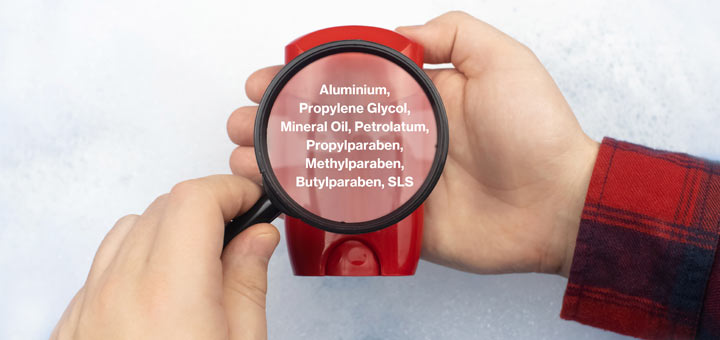Have you noticed that more and more personal care and skin care products have “paraben-free” labels lately? It’s not just your imagination, and the reason for this evolution in beauty products is because more and more research highlights potential human health risks associated with these chemicals. As a jumping off point, a growing body of research linked parabens to abnormal hormone function and certain cancers.
What Are Parabens?
Parabens are synthetic chemicals that are widely used as preservatives in personal care products and cosmetics. You can usually find them in shaving creams, shampoos, deodorants, cleansers, pharmaceuticals, foods, and beverages. Manufacturers include parabens in these products and more because they extend their shelf life. Additionally, parabens exhibit antimicrobial properties that prevent the growth of mold, fungi, and bacteria. There are several types of parabens and most products contain more than one. Common parabens in consumer goods include ethylparaben, butylparaben, methylparaben, and propylparaben.
According to research, some 90% of typical grocery items contain a measurable amount of parabens. Even those who steer clear of parabens in personal care or hygiene products can be exposed to these preservatives. What worries public health advocates is that cumulative exposure to parabens can contribute to a wide range of health problems. Some of the main concerns are the disruption of hormones, reproductive toxicity, and the increased risk of certain cancers. For example, parabens mimic estrogen by binding to estrogen receptors on cells. The perceived influx of estrogen can trigger reactions such as an increase in breast cell division and the growth of tumors.
Health Problems That May Be Linked To Parabens
As mentioned previously, parabens are hormone disruptors. This is because they can disrupt endocrine function, ultimately interfering with the hormones that are responsible for normal growth and development. Preliminary research from March 2021 linked hormone disruption from parabens to changes in several aspects of human health. Some of these changes included increased blood sugar and cholesterol levels, obesity risk, cognitive decline, and immune system dysfunction.
A lot of the research surrounding parabens, though, has been conducted on animals or testing paraben levels in urine. The urine tests aimed to discover if people with higher exposure to parabens had an increased risk of developing certain health issues. Some studies found that parabens in urine led to an increased risk of breast cancer. A separate study from April 2023 found higher levels of parabens in breast cancer tissues than in healthy breast tissue. Finally, some observational studies linked urinary levels of parabens to elevated breast cancer risks. That said, it’s hard to control other factors, such as age, genetic risk factors, and other environmental exposures.
In regards to parabens in cosmetics, the biggest source of human exposure, U.S. regulators haven’t found a clear enough risk of health harms to warn people against using them. As of 2022, the U.S. Food and Drug Administration (FDA), which regulates cosmetics, said that there wasn’t sufficient information to show that parabens in cosmetics had an effect on human health.
Risk Factors For Paraben Exposure
Paraben exposure is very common, especially in regards to methylparaben and propylparaben. One study examined urinary concentrations of different types of parabens in American adults. The results indicated that 99% of the participants had exposure to methylparaben, and nearly 93% of participants had exposure to propylparaben. Even though a lot of people have some exposure to parabens, some people are at higher risk of exposure than others. According to the Centers for Disease Control and Prevention (CDC), higher-risk individuals include Black people, women, and adults over the age of 20. Anyone who uses more personal care or hygiene products may be at more risk of exposure, depending on the products.
How To Limit Paraben Exposure
If you want to limit your exposure, start by reading product labels, be they for beauty, personal care, or food. Some parabens are more likely to interfere with the body than others, so keep your eyes peeled for butylparaben and propylparaben, as they are more likely to cause health risks. Those are long-chain parabens, whereas methylparaben and ethylparaben are short-chain parabens. Short-chain parabens are much less likely to disrupt hormone function. As we mentioned in the beginning of the article, a lot of products are paraben- or sulfate-free, so aim to use those products. Lastly, don’t assume that something with a “clean” or “natural” label is paraben-free. Read the labels and you’ll find the truth, and potentially become healthier in the process.

Vincent Stevens is the senior content writer at Dherbs. As a fitness and health and wellness enthusiast, he enjoys covering a variety of topics, including the latest health, fitness, beauty, and lifestyle trends. His goal is to inform people of different ways they can improve their overall health, which aligns with Dherbs’ core values. He received his bachelor’s degree in creative writing from the University of Redlands, graduating summa cum laude. He lives in Los Angeles, CA.






















